There is a growing pattern amongst sporting institutes who are announcing they have a trans inclusive approach to participation in sports. This extends to individuals who do not have legal recognition of their preferred sex. There are many examples worldwide but I will limit examples below which directly affect Scotland.
1/ LGBT Youth Scotland guidance issued to every school in the country offers the following advice.
“If school competitions or classes are organised by gender, a transgender young person should be allowed to compete in the category which matches their gender identity. For a non- binary young person, check which group they would feel most comfortable being with
For inter-school competitions not governed by national sports bodies, the same standards should apply. It may be helpful to a young person if you speak to the equivalent staff in the other school(s) to let them know there is a trans learner in your team/competition, but only with the young person’s consent.”
(‘Gender Identity’ meaning a persons self declared sex.
2/ WFTDA Roller Derby accepts a self declaration of a persons sex for appointment to their female team
3/ British Gymnastics accepts a self declaration of a persons sex for persons Under 16 and eligibility to female only competitions.
4/ Equality Network has produced a Scottish LGBT Sports Charter with this aim –
“We want Scotland to be a country where everyone can take part, enjoy and succeed in sport at all levels whatever their sexual orientation or gender identity.”
(‘Gender Identity’ meaning a persons self declared sex.)
It has five principles, two of them being –
“Develop policies and practices that are inclusive, informed by a better understanding of the issues and barriers for LGBT people and by taking advantage of training.”
“Work to further include trans people in sport by understanding the differing needs for trans participants and begin to reduce the barriers which prevent trans people from taking part in sport in their acquired gender.“
There is a long list of signatories to this LGBT Sports Charter.
Whilst I applaud the sentiments of the other principles of this Charter to stamp out homophobic and transphobic discrimination and harassment within sports, I am deeply concerned by the two principles highlighted above. If policies are to be re-written that permit the self declaration of a persons sex to then be included within girls and women’s teams then that will effectively be the end of female sports. There can be no doubt in anyone’s mind that male and female sports are separated on the basis of sex due to the advantage of the increased strength, stamina and size difference that male competitors have over female competitors.
Whenever I have raised concerns about this issue with MSP’s I get a reply with a quote from the Equality and Human Rights Commission (EHRC) website. The advice quoted is this small vague statement which doesn’t provide enough detail of what the laws and guidance actually are. If this were to be taken as being a true reflection of Equality law and applied generally then it’s not surprising that we have policies and charters as detailed above.
“An association must not restrict the participation of a transsexual person in such competitions unless this is strictly necessary to uphold fair or safe competition. In other words, a transsexual person should be treated as belonging to the sex in which they present (as opposed to the physical sex they were born with) unless there is evidence that they have an unfair advantage, or there is a risk to the safety of competitors which might occur in some close-contact sports.”
The Gender Recognition Act 2004 recognises differences in the sexes and permits sporting authorities to prohibit or restrict persons who are issued with a gender recognition certificate to participate on the grounds of fair competition and safety of competitors
“if the physical strength, stamina or physique of average persons of one gender would put them at a disadvantage to average persons of the other gender as competitors in events involving the sport.”
The Equality Act 2010 also includes exemptions in relation to sports in which it states that sporting groups can discriminate against trans persons with the protected characteristic of gender reassignment if they are actively excluded from participating to ensure fair competition or safety of competitors. This applies to all trans persons whether or not they have been issued with a gender recognition certificate.
“A gender-affected activity is a sport, game or other activity of a competitive nature in circumstances in which the physical strength, stamina or physique of average persons of one sex would put them at a disadvantage compared to average persons of the other sex as competitors in events involving the activity. “
The Sports Council Equality Group which represents the 5 Sports Councils across the UK, including our national agency sportscotland recognise this essential need for equality in sports. They have issued guidance around the eligibility of trans people in sports which is very detailed and breaks down the various different circumstances (i.e. pre/post puberty, hormone treatment etc) and it crucially applies the principles of fair competition and safety of competitors as is required in sport.
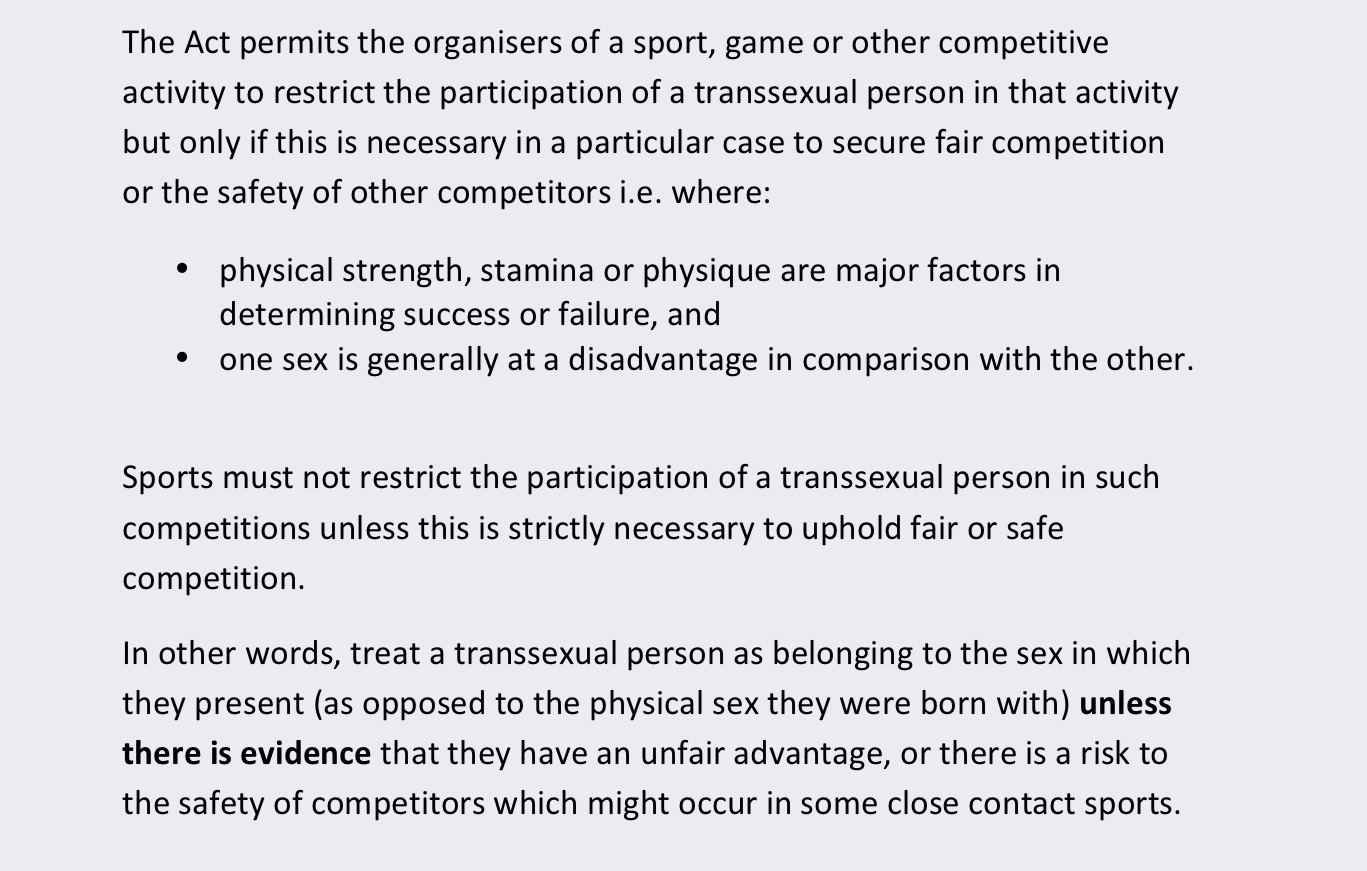
They first acknowledge that trans people shouldn’t be prevented from participating in sports of their preferred sex unless there is evidence of an unfair advantage, as per the EHRC statement above.
But the next few pages of this guidance are extremely important as the eligibility criteria is laid out in very simple easy to read tables. This is what it says for non-contact sports.
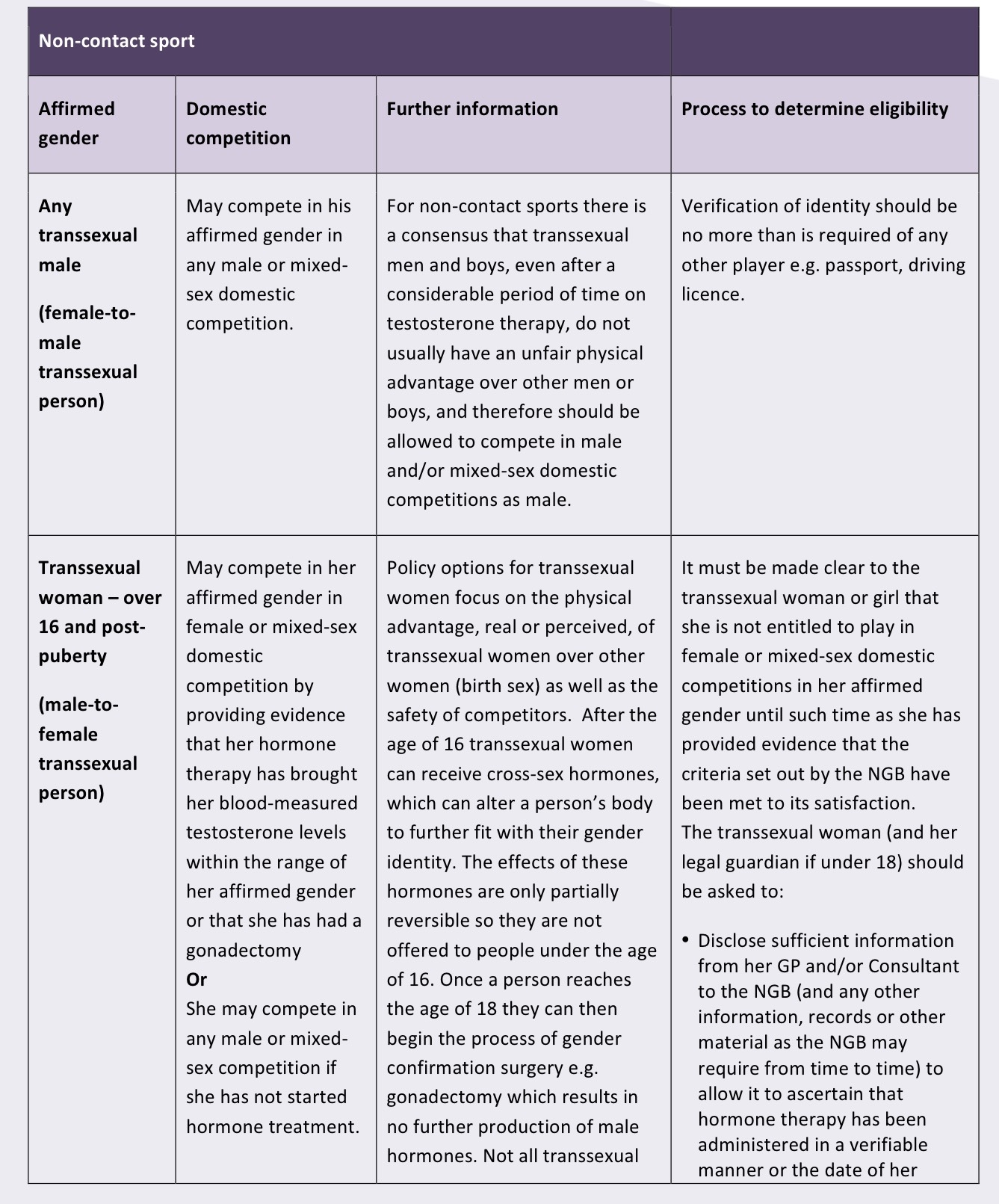
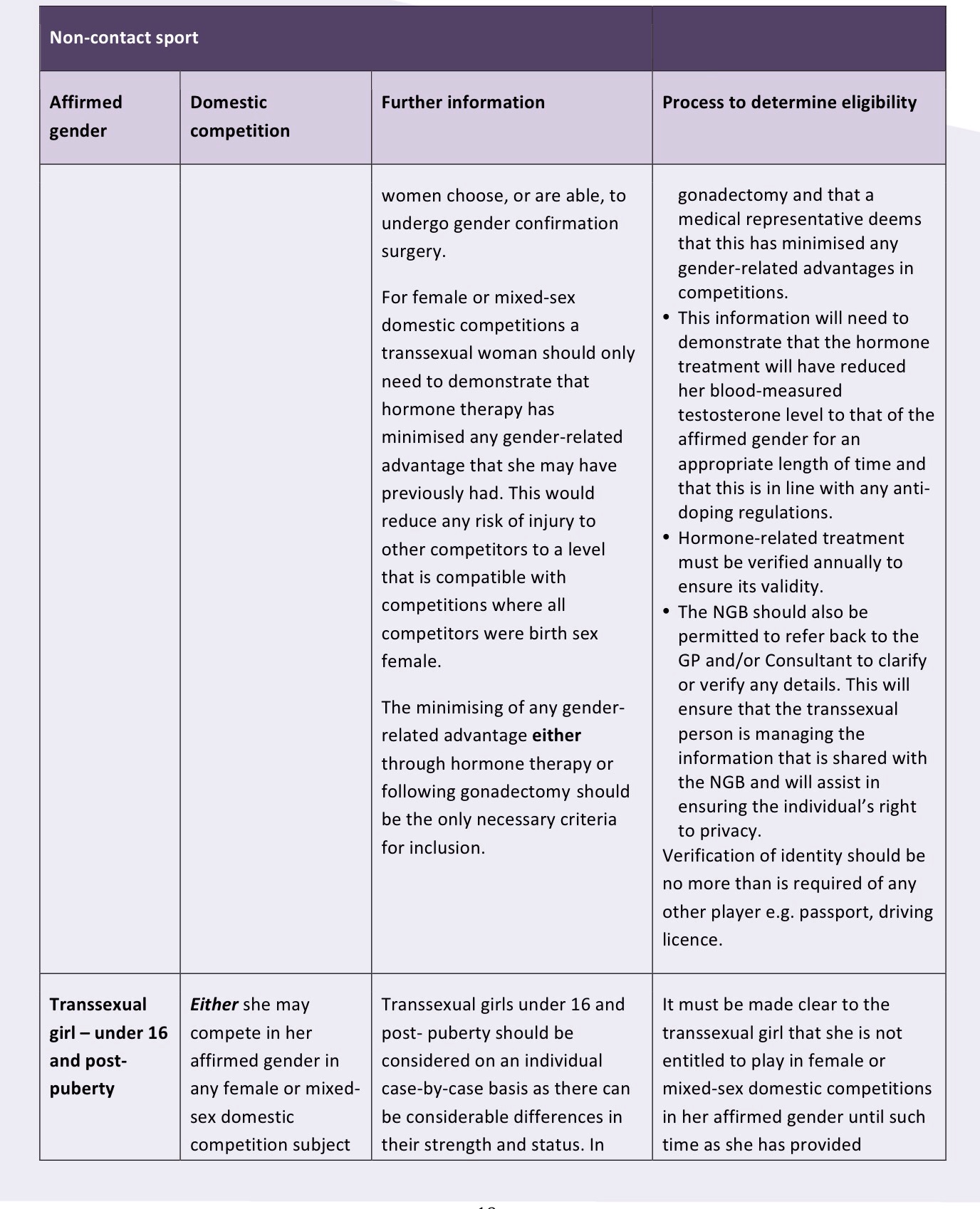
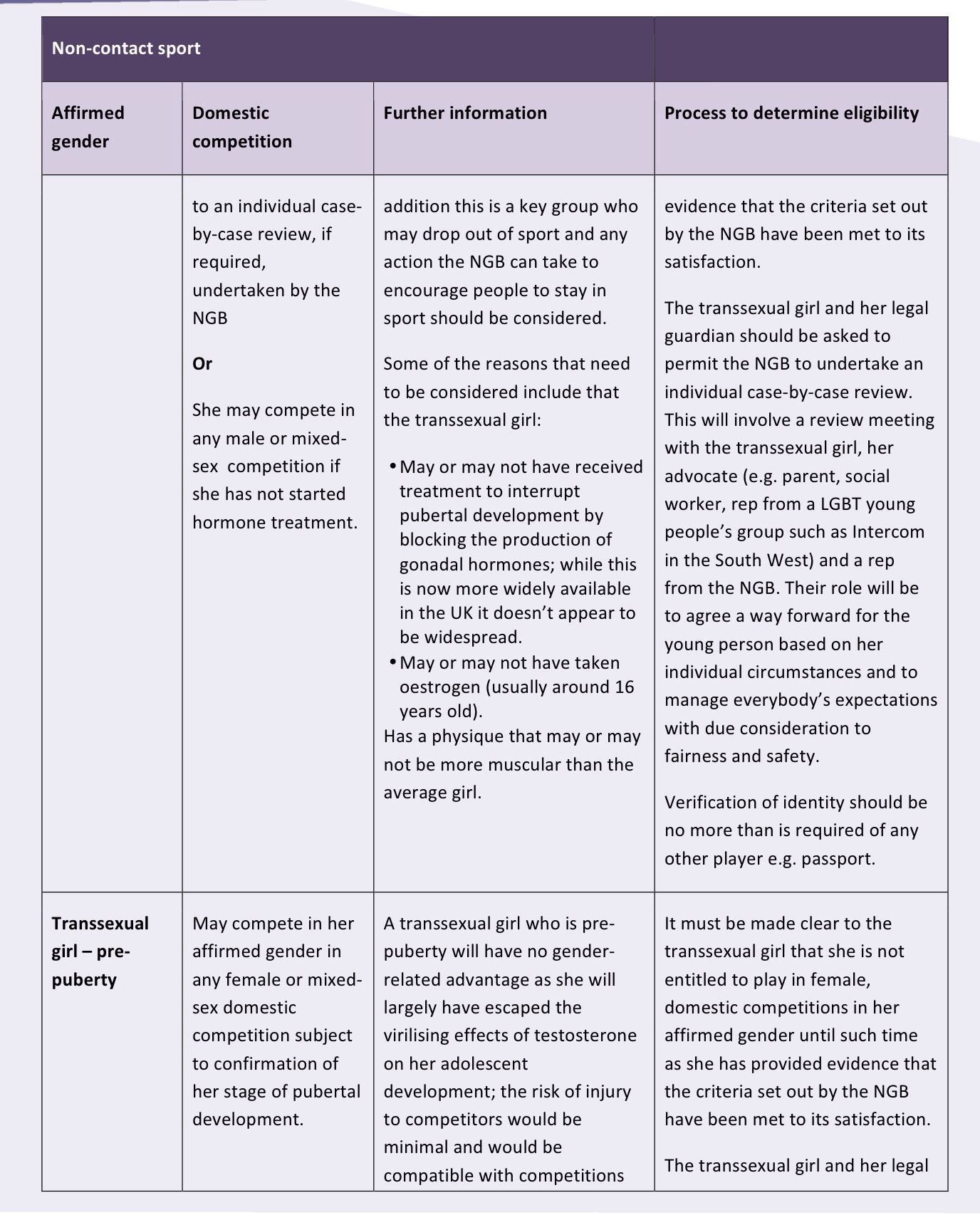
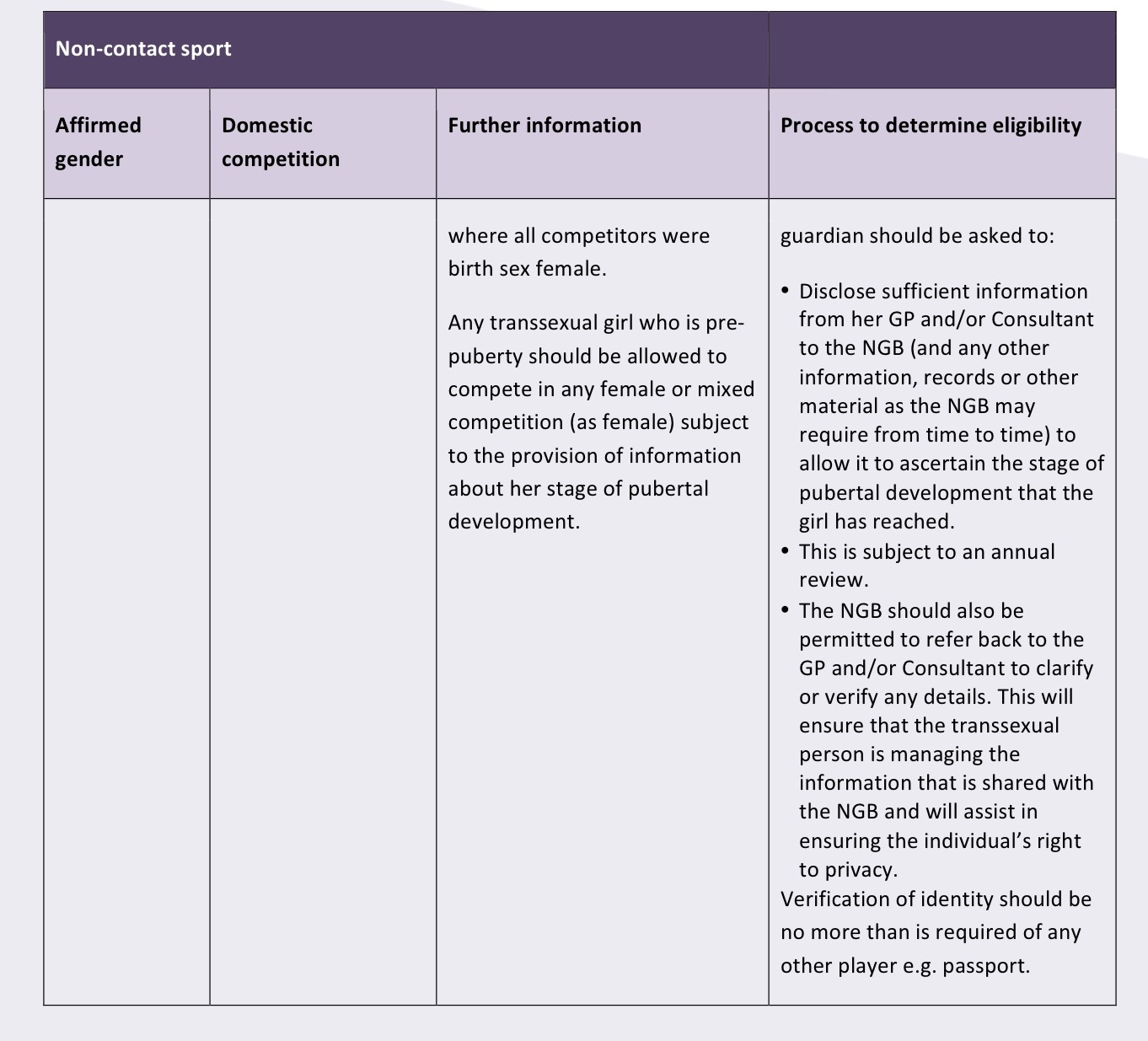
Female to male transsexuals have no process to go through and are automatically eligible to participate in men’s sports. Male to female transsexuals on the other hand have many requirements to meet. The starting point for every age category, including pre-puberty is that they are not permitted to compete in women’s or girls sports until evidence is produced that they meet the required criteria. It’s clear that the onus is on the individual to prove they are eligible. It’s not the other way around as the policies above are suggesting.
“It must be made clear to the transsexual woman or girl that she is not entitled to play in female or mixed‐sex domestic competitions in her affirmed gender until such time as she has provided evidence that the criteria set out by the NGB have been met to its satisfaction.”
These are the current regulations and laws on the equality in sports, and women are asking for sporting bodies and government funded groups to respect, act and advise accordingly within these laws.
Scottish Trans Alliance, Equality Network, Stonewall Scotland and LGBT Youth Scotland have all lobbied the UK Government to amend the Equality Act 2010 to include a protected characteristic of ‘Gender Identity’. The Government responded that no changes would be made to the Act and therefore ‘Gender Identity’ is not recognised as a valid definition within any legislation. These three groups have been given funding and tasked to influence policies across many sectors in Scotland, including in this case Sporting groups, and all frequently reference the term ‘Gender Identity’. Both Scottish Trans Alliance and Stonewall asked for all of the single sex exemptions within the Act to be abolished, and Stonewall specifically requested this sporting exemption (detailed above) to be removed within their submissions to the UK Women & Equalities Committee.
It is incredibly alarming that these groups are advising sectors across Scotland on how to change their policies to be more LGBT inclusive yet instead of advising them on what the current laws are they are instead promoting what they would like the laws to be. I’m asking that the policies, training and advice provided by these groups on behalf of the Scottish Government are urgently reviewed to ensure they comply with the current legislation. The self declaration of a persons sex is not recognised in any UK legislation, there is no Act which declares a person must be treated as the sex their preferred gender aligns to. There IS legislation that upholds that Sex is a protected characteristic and permits trans people to be excluded from single sex spaces, services and sports, regardless of their recognised legal gender.
The UK Government made an announcement in Summer 2018 confirming that they have no plans to make any changes to the Equality Act 2010 regardless of any findings from the outcome of the current Gender Recognition Act consultation. With this is mind, it is imperative that all legislation, policies and guidelines produced either directly or indirectly by the Scottish Government uphold the sex based protections provided to women and girls as stated within the Equality Act 2010. Self Identification of sex is not legally binding in any legislation nor is ‘Gender Identity’ a recognised protected characteristic.
Policies and guidelines need to be explicitly clear when exemptions can be applied because as it stands now the rights of girls and women are being routinely ignored.
UPDATE 23/1/19
Scottish National Championship events will now include a non-binary gender category within the event entry options. Scottish athletics have published their Policy on Non-Binary Athletes which acknowledges the likelihood that for many events it wouldn’t be possible to hold separate non-binary events, and therefore all non-binary athletes will be required to compete in the male races, which of course is the common sense action to take. Maybe not all hope is lost, the sporting organisations certainly appear to understand the physical differences between the sexes. We just need to make sure this message is correctly filtered down to smaller organisations, and educational establishments.
Q: Why are non-binary athletes required to run alongside the male race?
Rationale: The inclusion of a non-binary category in a women’s only race must not interfere with the head to head competition at the front of the Championship race, it is feasible that a non-binary athlete who is ineligible to compete in the female category running in a women’s only race could have a physiological advantage to other athletes within that race. We must consider our female membership and allow them a playing field free from potential outside interference. The larger density of athletes and range of ability within a men’s only race allows for fairer competition.
